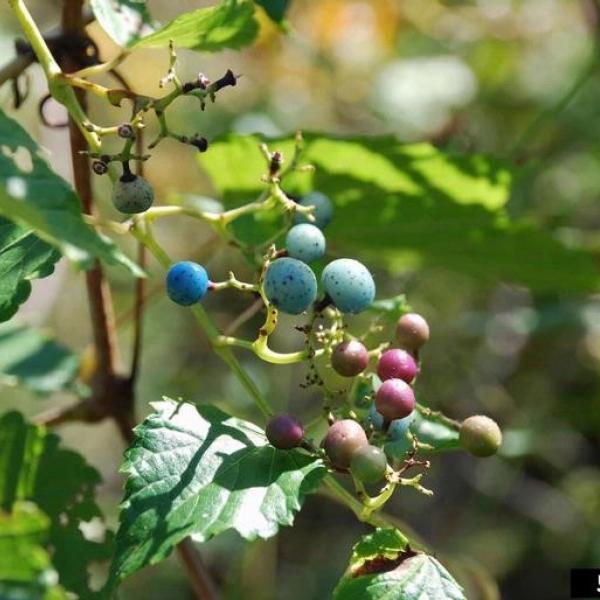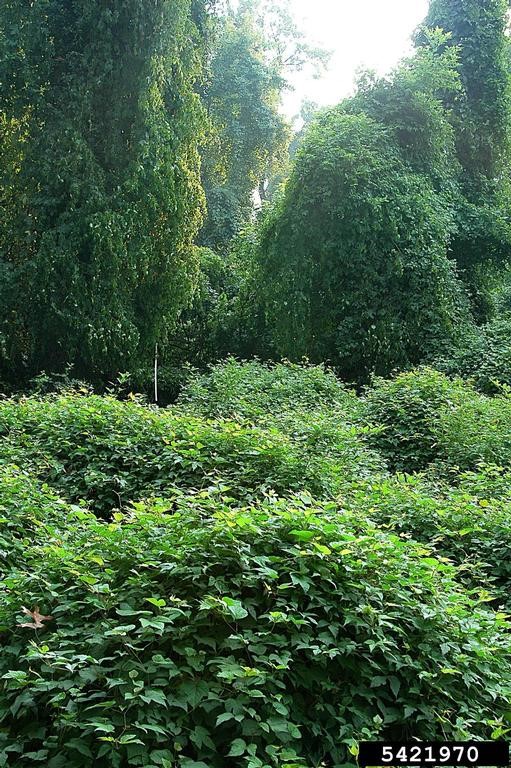
Author: Elizabeth Spinney, Invasive Plant Coordinator, Vermont Department of Forests, Parks & Recreation
Despite the snow falling outside my window this morning, I know that the Vermont growing season will soon be in full swing. We’ll soon see in our forests the spring ephemerals blooming, tree buds bursting, and the swaying strands of various vining plants. These trellis’ of wild grapes and Virginia-creeper always remind me of one invasive plant we should all be looking for: Porcelainberry (Ampelopsis brevipedunculata (syn: glandulosa)). Also known as “amur peppervine”, “creeper”, and “wild grape” it has been widely planted as an ornamental plant, even available online for purchase. However, it is now recognized to be highly invasive in habitats like forests and forest edges. Many of us may be dreaming of our gardens and yards as a means of distraction right now (I know I am!). As we shop (mostly online at the moment) we need to consider the potential invasiveness of any new plant, and resist the temptation to order new and interesting exotic plants from online without first researching the potential impact it could have on Vermont's forests and forest economy.
The presence of this species in the US was first recorded in the late 1800s, as a landscape and ornamental plant. This deciduous, woody vine which can reach heights over 20’, originates from east Asia. The leaves have serrated margins and are heart-shaped to deeply lobed. Other identifiers include the presence of obvious lenticels (gas exchange pores in the bark—think of the spots on a cherry tree), as well as solid white centers to the vine (pith). The best time to identify it is in the fall, when you might spot the colorful fruits as they transition from speckled robin’s-egg-blues to deep purples. Those various colors are a result of a change in pH of the fruit as it ripens. The primary mode of spread is through wildlife and human activity moving the seeds in the fruit.
Porcelainberry can be found in disturbed habitats and in landscaping, the shores of lakes and rivers, marshes, forests, and forest edges. This species belongs to the grape family (Vitaceae), along with Virgina-creeper (Parthenocissus quinquefolia) and the native grapes (Vitis spp.- summer grape, fox grape, river grape). The native grapes like fox grape have a brown pith and lack obvious lenticels.
As one of the common names suggests, it can be confused for the true wild grapes (Vitis spp.). Those dark colored fruits, the twining vining nature of its growth, and the leaf shape all assist in this confusion.
While widely distributed as an ornamental plant, it has only been officially recorded to have escaped and spread in natural habitat in New England in the states of Connecticut, Massachusetts, New Hampshire, Rhode Island, and New York. It is not currently recorded in natural habitat in Vermont, and therefore it is considered an early detection species of concern.
Its ability to grow in a variety of conditions (light, soil, temperature), and hearty root system mean vines can persist when escaped from an ornamental planting. Rapid and dense growth of this plant means that Porcelainberry can smother other understory vegetation, and even climb and overgrow trees. The environmental impact it’s had in other New England states has led to its listing on the unofficial Vermont Watchlist.

If you find porcelainberry growing outside of an ornamental planting in Vermont, please report it on VTinvasives.org.
To learn more about Porcelainberry, check these additional resources:
- Invasive Plants and their Native Look-alikes Guide
- Native Plant Trust
- US Forest Service Fact Sheet
- US Fish & Wildlife Service Fact Sheet
- EDD Maps
- Pennsylvania Department of Conservation and Natural Resources Fact Sheet
- Invasive Plant Atlas
- Brooklyn Botanic Garden
Photo Credits
Top: Leaves and colorful fruits of an invasive Porcelainberry, N. Loewenstein, Auburn University, Bugwood.org
Bottom: Porcelainberry infestation, S. Manning, Invasive Plant Control, Bugwood.org